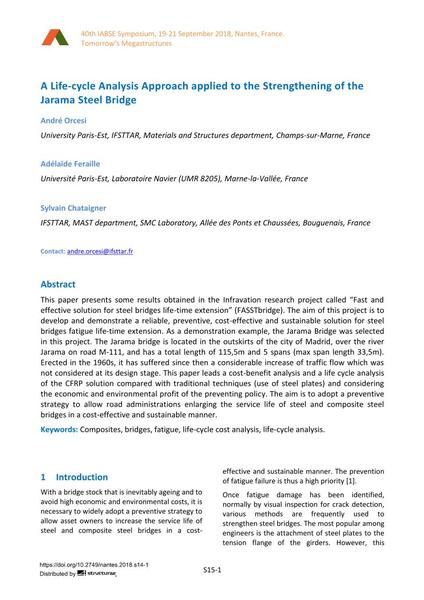A Life-cycle Analysis Approach applied to the Strengthening of the Jarama Steel Bridge

|
|
|||||||||||
Détails bibliographiques
| Auteur(s): |
Andre Orcesi
(University Paris-Est, IFSTTAR, Materials and Structures department, Champs-sur-Marne, France)
Adélaïde Feraille (Université Paris-Est, Laboratoire Navier (UMR 8205), Marne-la-Vallée, France) Sylvain Chataigner (IFSTTAR, MAST department, SMC Laboratory, Allée des Ponts et Chaussées, Bouguenais, France) |
||||
|---|---|---|---|---|---|
| Médium: | papier de conférence | ||||
| Langue(s): | anglais | ||||
| Conférence: | IABSE Symposium: Tomorrow’s Megastructures, Nantes, France, 19-21 September 2018 | ||||
| Publié dans: | IABSE Symposium Nantes 2018 | ||||
|
|||||
| Page(s): | S14-1 | ||||
| Nombre total de pages (du PDF): | 9 | ||||
| DOI: | 10.2749/nantes.2018.s14-1 | ||||
| Abstrait: |
This paper presents some results obtained in the Infravation research project called “Fast and effective solution for steel bridges life-time extension” (FASSTbridge). The aim of this project is to develop and demonstrate a reliable, preventive, cost-effective and sustainable solution for steel bridges fatigue life-time extension. As a demonstration example, the Jarama Bridge was selected in this project. The Jarama bridge is located in the outskirts of the city of Madrid, over the river Jarama on road M-111, and has a total length of 115,5m and 5 spans (max span length 33,5m). Erected in the 1960s, it has suffered since then a considerable increase of traffic flow which was not considered at its design stage. This paper leads a cost-benefit analysis and a life cycle analysis of the CFRP solution compared with traditional techniques (use of steel plates) and considering the economic and environmental profit of the preventing policy. The aim is to adopt a preventive strategy to allow road administrations enlarging the service life of steel and composite steel bridges in a cost-effective and sustainable manner. |
||||
| Mots-clé: |
ponts
|
||||
